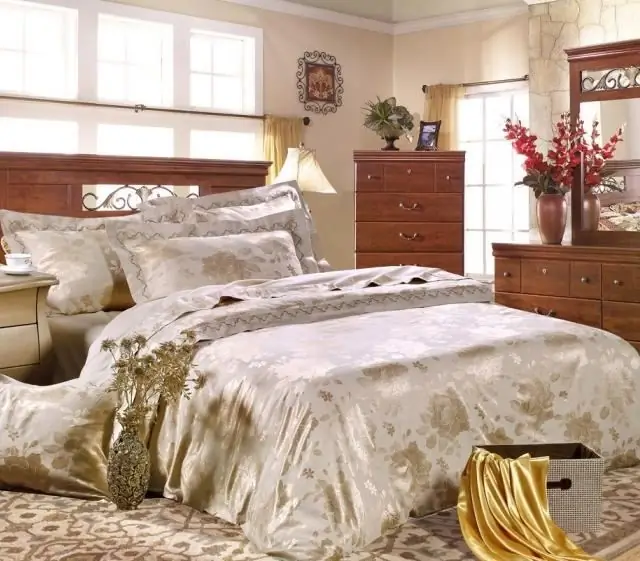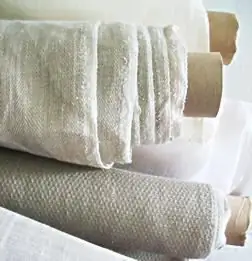2025 Author: Priscilla Miln | [email protected]. Last modified: 2025-01-22 17:55:18

The first mention of linen fabric and its use can be dated back several millennia. Some historians define its age as 5000 years. Its earliest use is in Ancient Egypt. It was an expensive material, so only we althy families, the pharaoh's family and courtiers could afford clothes and textiles. Mummies of pharaohs were also wrapped in linen.
Among the Slavic peoples, linen fabric became known somewhere in the 9th century. Thanks to the properties of plant fibers, textiles and clothing were both thin and durable, allowing the products to be used for a long time. Unlike other countries, linen was not a luxury. Clothing could be seen among representatives of various social classes. The difference was in the thickness of the fibers, the finish and the presence of dyeing in the fabric.
From the moment Empress Catherine II allowed linen threads to be exported outside the state, most of the weaving factories in Europe worked on fibers grown in the Russian Empire.
Plant, growing conditions, distribution areas
Cultural linen, which is used forvarious industrial purposes, there are various types. Basically, the crop is grown for seeds, fibers or oil. Fiber flax is used for the production of fabrics. The stems from which the fibers are obtained may be different, the quality of the obtained threads depends on them.

Flax is tricky to grow. It is best to grow the plant in regions with a temperate climate and non-chernozems. The culture is very demanding on the composition of the soil, mineral fertilizers in it and the weather - precipitation during the ripening period can ruin the entire crop. At the same time, seedlings appear in early spring, at a temperature of +4-5 degrees, and can withstand frosts down to -4 degrees. From the moment the first sprouts appear to the harvest of flax, it takes from 68 to 84 days. In Russia, the culture is grown in various regions, on areas that number in the thousands of hectares. But very little land is given over to the cultivation of a variety that provides the best raw material for the production of fine fabrics. Therefore, the products are quite expensive.
Obtaining linen fibers and their processing
To obtain the finest and finest fibers, there is a certain harvest time, because the finer the raw material obtained, the better the linen. The stems of the plant should be light yellow, the seed pods should be green. Flax is gathered together with the roots and soaked so that the necessary fibers are separated without obstruction from the rest of the fabrics. Then it is dried and sent to production.
Further processing is not muchdifferent from that used in antiquity. Linen is wrinkled, pulled and combed. Only in modern factories such operations are performed by machines.
How linen fabric is made
The production of linen fabrics is quite expensive for several reasons. First of all, this is the complexity of processing the plant. In addition, fiber flax comes in different varieties, and the quality of the fabric and the complexity of production directly depend on this. Linen fabric can be thin or thick, coarse or smooth, depending on the length of the resulting plant fibers.
After the harvest is harvested, the raw material goes to the flax processing plants. After being processed by a scutcher, long and short fibers are obtained, which, although considered waste, are used to produce such products as coarse linen.

The resulting threads are compared according to their technical characteristics with GOSTs and distributed for further processing. Long fibers are used to produce fabric in the textile industry. From the tow, the bases for finishing materials and floor coverings are excellent. Waste fibers that do not meet any of the standards are used in construction in the form of tow.
Types of fabrics
Linen fabric is divided into technical and household. However, the former are produced in larger quantities than the latter, since cheaper substitutes have been found from chemical fibers or non-woven materials. They can be pure linen or blended. For this, theycotton, viscose, lavsan are added.

Depending on the purpose, linen fabric is divided into towel, dining, canvas, suit and dress, lining, canvas, bed and linen. For tailoring, they use such as cambric, bortovka, matting, kolomenok, fine linen. Canvases for drawing are made from Ravenduk and canvas. Teak and Damascus are used for furniture upholstery. Overalls, shoes, travel accessories are made of canvas.
Properties of linen fabrics
Despite the variety of fabrics and materials from which they are made, linen remains in demand. This is due to its features and qualities. First of all, it is worth noting the high hygroscopicity of the fabric: it perfectly absorbs moisture. Thanks to the use of linen clothes, you can avoid heat stroke, or, more simply, overheating. The fabric keeps you cool in hot weather and warm in cold weather. In addition, it does not accumulate static electricity, which has a positive effect on overall well-being.

All the properties of linen fabric can be listed for a long time, what is its ability to inhibit pathogens. It acts as an antiseptic, so it is not only environmentally friendly, but also very hygienic. In addition, linen fabric does not cause allergies, which allows its use for children's textiles, medicine and in those places where an increased level of sterility is required.
All things that use the fibers of this plant havelong service life, easy to clean and wear well. Linen clothing does not turn yellow, but only bleaches over time.
A fly in the ointment
The biggest disadvantage of linen fabric is that it is very difficult to iron after washing. However, the process can be simplified by ironing slightly damp items or by using a steam iron. It is better to store clothes made of such material on a hanger in a wardrobe, and not in a closet on a shelf. Then things will last longer.
Recommended:
Technical rubberized fabric: production and application

Many rubber goods are made using rubberized fabric. It has excellent mechanical strength inherent in the textile base. Among the complex of technical properties of the material, one can single out low gas, vapor and water permeability, high resistance to aging and abrasion, to various aggressive environments
Silk fabric: types, description, properties and applications. Natural and artificial silk

Silk fabric is woven from natural, synthetic and artificial threads. The last two variations can be safely attributed to one group - chemical. Artificial silk is made from cellulose with chemical impurities, it has different characteristics and more affordable cost
Chiffon fabric: description, composition, properties and application

Chiffon allows you to create original and light models of dresses, blouses, shawls, scarves. Don't limit yourself to special occasions, chiffon outfits are great for everyday wear too. What is chiffon, its composition, how and with what to wear, which type is better to choose? Read about all this in the article
Natural silk threads - production features and basic properties. The magical properties of the red thread

Even in ancient times, fabrics made from natural silk threads were highly valued. Only very we althy representatives of the nobility could afford such a luxury, because. in terms of value, this commodity was on a par with precious metals. Today, interest in natural silk fabrics is only growing
Rami fabric: composition, properties. nettle fabric

The trend in the fashion world is clothing made from natural materials. More and more people prefer products made on the basis of natural fabrics. In our article we will talk about what ramie fabric is, what are its features and advantages

